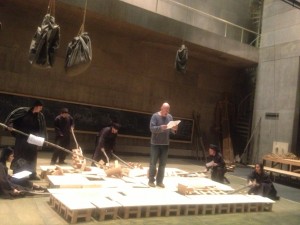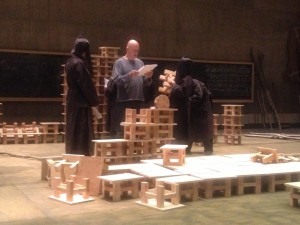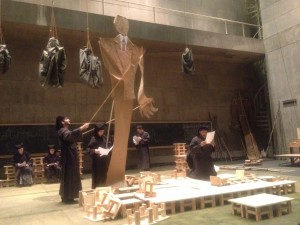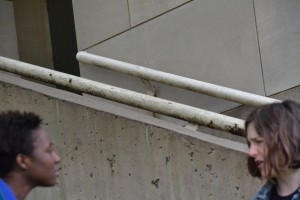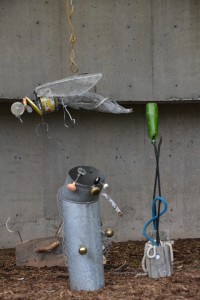Aileen Lambert ’16 meets with Emmie Finckel ’14 to talk about her time at Wesleyan, her senior thesis in scenic design, and her involvement with the Theater Department production of Anton Chekov’s “The Seagull.” Directed by Associate Professor of Theater Yuri Kordonsky, the play explores the question of “What defines art and how can we create something new?” In order to further exemplify this theme, Professor Kordonsky is leading a production set in an unusual environment where the boundaries between the actor and the audience member dissolve, designed by Ms. Finckel.

Give me some basic background on your theater experience here at Wes.
So I transferred here, that’s a thing that happened. Second semester of sophomore year I stage-managed Dr. Faustus Lights the Lights (directed by Associate Professor of Theater Cláudia Tatinge Nascimento). Which was really nuts that I stage-managed a faculty show after only being here a couple of months. That was really a crash course in Wesleyan theater. And then first semester last year I designed The Tempest (directed by Nicholas Orvis ’13) And then second semester last year I stage managed Eurydice (directed by Sivan Battat ’15) for Second Stage, and I also designed the set for Under Milkwood, which Nick also directed.
Your thesis focuses on breaking the boundaries between the audience and the actors. What prompted this idea?
The whole way through I had been planning on doing either a directing thesis or writing something, because I’m a sociology double major, and I think there’s a lot of interesting theoretical overlap between performance studies and sociology. And then I took set design, and Marcela (Oteíza, Assistant Professor of Theater) stole me. Marcela really showed me how the set is a mediator in the audience/performer relationship. What is most interesting to me about theater is that it’s the only art form that you really can’t do without an audience; the audience is an absolutely essential part of that. So, that’s why this idea of the audience/performer relationship became what I wanted to focus on.
Then in taking that class with Marcela, we did a lot of reading, a lot of Richard Schechner stuff, which is all about environmental theater, and trying to make the audience and performance space one cohesive thing. Richard Schechner was this guy in the 1960s who came up with this idea for environmental theater, which tries to treat the space as it is, and not trying to hide it in any way. You go and see these shows that have these painted flats up against the walls very clearly pretending to be something they’re not, so the idea behind environmental theater is that you’re not trying to pretend—the set is the environment. So it’s a lot of thinking about how different pieces function rather than how they look. And it’s also a lot about trying to use the space to impose upon and affect the audience in a way that will serve the play.
All the pieces fell into place, when that was what I decided I wanted to focus on theoretically, and Yuri (Kordonsky, Associate Professor of Theater) decided that was what he wanted to focus on physically. I was talking to Marcela about designing whatever this show that is happening right now as my thesis, and then it all just kind of—I mean, Jack (Carr, Chair of Theater Department) always says that he got my thesis proposal and Yuri’s concept idea for The Seagull at the same time, and was just sort of like, “Wow, ok cool.”
What has been your greatest lesson learned so far in the production process?
This has made me realize just how important communication is, and that means a lot of different things. On one hand, there’s just the fact that theater is a collaborative art and everyone needs to know what’s happening at the same time, and that can be tricky. Then, when you’re trying to talk about these visual elements, I can say that I want a blue chair over there, and the blue chair that I have in my head is definitely different than the blue chair that you have in your head, which is different than the shade of blue that the guy who is going to paint the blue chair is thinking of. So trying to establish a language to communicate about these more abstract ideas is definitely the biggest challenge, but also sort of the most fun thing to try and figure out.
Is scenic design something you want to go into? Do you have career aspirations that relate to this?
Well, I think I definitely want to do something in theater because I think that theater is really important, and I think that you can communicate things through theater that can’t be communicated any other way. But, I think that a big problem is that people don’t really know how to engage in theater, so they get thrown off by these more abstract productions that I think have a lot of power to do things. One of the greatest things about theater is that you don’t have to know how to engage with it, you just have to let it happen to you. I don’t know what avenue it’s going to take, but I want to help people to understand that. I could see myself trying to do the design route, but, for me, the idea of having to jump from project to project and not have an actual job—I don’t like that. But then I could also see myself going into theater management and the business side of things, and I could also totally see myself going the academia route and working towards being a professor, and really getting into the theory/performance side of it.
What has been your favorite class so far at Wes?
Any class?
Any class.
Linear algebra was totally my favorite class. I actually initially was going to be a triple major, with math also. I love math. Linear algebra was the first class I ever took that made me realize how little I know about everything because we were learning how to add and subtract and divide and multiply again but with different things, instead of just single numbers, which made the world of math go from being this big to being just so much you can do with it that I have no idea what it is. That was really cool.
What has been your favorite moment so far in the production process?
My favorite moment was definitely that first day when we got everything in the space. It was all lined up against the back wall of the theater, and then Yuri gave his little spiel—the whole cast was going to play, and were going to figure it out. Then he said, “Emmie, can you tape out the platform?” That took about 10 or 15 minutes, and then I stood up and looked around, and the whole set was there. And it was awesome! It was awesome because I didn’t actually have to touch a single piece of furniture to make it move, but it was also cool because the thing that’s most important for me in thinking about this process is that the work that I’m doing is happening with the work that is happening in rehearsal. There were a bunch of times when Marcela would say to me, “You’ve really got to think specifically about how this is going to look visually.” I would go to my room and start sketching and I would feel really weird because I was like, this, whatever I’m coming up with right now, is going to be so radically different from what they are coming up with at rehearsal, and it seemed very disconnected. It was really nice to have that moment where it felt like the work that I was doing was happening with everybody else, and happening collaboratively, and knowing that all these people who were moving stuff around the space were working with this material in rehearsal and were being conscious of how the things that they were doing were working with the play. That was the first moment when I felt that my world and the actor world were really coming together, and it happened so seamlessly.




